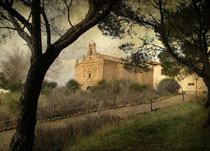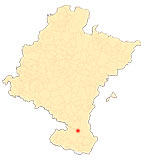Sanctuary of Nuestra Señora del Yugo
By Ricardo Fernández Gracia
Secular devotion
The origin of the secular devotion to the Virgin of the Yoke, in Arguedas and in other localities in the area, is lost in time, without it being possible to specify the date of the legend of her appearance, which the popular imagination places around the year 1189, a date that coincided in 1889 with the singular celebrations in the sanctuary on the occasion of the 13th centenary of the 3rd Council of Toledo.
The legend, beautiful like many others, has elements that are repeated in numerous Marian dedications: the tree (a pine tree), a farming tool (the yoke), the apparition, the initial disbelief of the neighbours, the miracle in the devout person (a lame farmer) and the reception and reception of the image by the authorities and the whole town. The first historical testimonies take us to the middle of the 14th century, when the mayor of Arguedas bought a piece from the workers of "Sancta María del Iugo".
The feast of the apparition was traditionally celebrated on 25 March, the day of the Incarnation, which was moved to the second day of Easter if there was an impediment due to it coinciding with Holy Week. In 1863 the town made a vow to celebrate sung mass with a sermon on the day of the Dulcísimo Nombre de María. Some pilgrimages were quite eventful, such as the one in 1619 in which Arguedas, Valtierra and Mélida took part, in which the pilgrims came to blows, leaving member of the clergyinjured and the beneficiary with a tear in his hand and the processional cross in pieces.
With regard to the rogations, we know of some solemn ones such as those held in 1817, for the drought, in 1834 in a context of plague and war, in 1854 for cholera and in 1889 to celebrate the VIII Centenary of the apparition, with a large gathering of several thousand people.
-
MUNÁRRIZ, L., El santuario del Yugo, Pamplona, Imprenta y Librería de Joaquín Lorda, 1898.
-
GARCÍA GAÍNZA, M. C. and others, Catalog Monumental de Navarra. I. Merindad de Tudela, Pamplona, Government of Navarre-Archbishopric of Pamplona-University of Navarre, 1980.
-
FERNÁNDEZ-LADREDA, C., Imaginería medieval mariana, Pamplona, Government of Navarre, 1989.
-
FERNÁNDEZ GRACIA, R., "Un aspecto de la arquitectura barroca en Navarra: los camarines", conference proceedings del I congress General de Historia de Navarra. Príncipe de Viana (1988), appendix 11, pp. 149-158.
-
ECHEVERRÍA GOÑI, P. and FERNÁNDEZ GRACIA, R., "La arquitectura religiosa de los siglos XVI al XVIII en Navarra", Ibaiak eta Haranak. Guía del Patrimonio artístico y paisajístico. Navarra, vol. VIII, San Sebastián, Etor, 1991.
-
AZANZA LÓPEZ, J. J., Arquitectura Religiosa Barroca en Navarra, Pamplona, Government of Navarre, 1996.
-
FERNÁNDEZ GRACIA, R., The Baroque altarpiece in Navarre. Pamplona, Government of Navarre, 2003.












